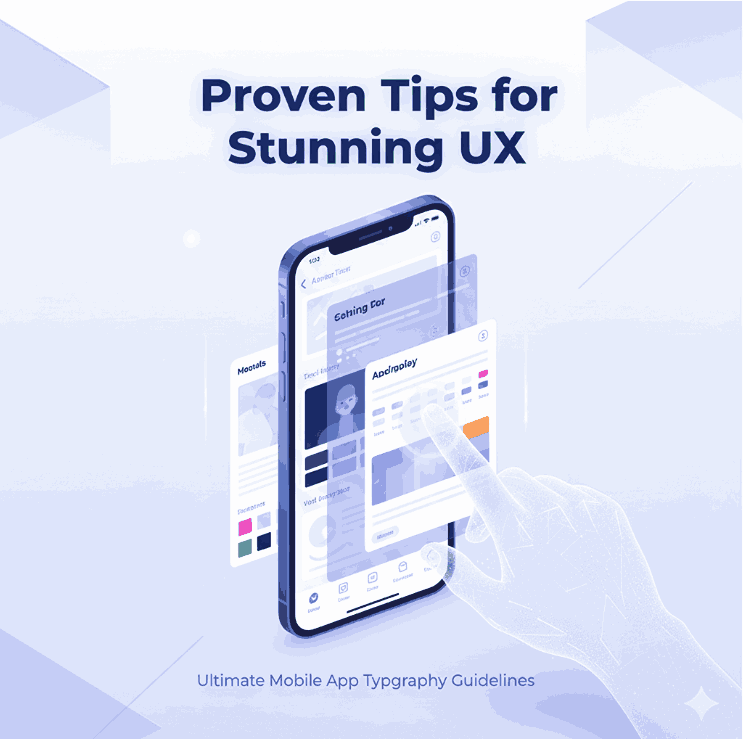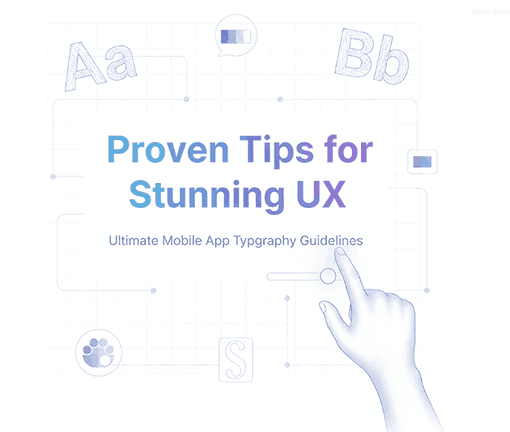
Table of Contents
- Introduction: Why Typography Matters in Mobile Apps
- Key Principles of Mobile Typography
- Font Selection: Typeface, Weight, & Style
- Hierarchy, Scale, and Line Height
- Legibility, Contrast & Color Choices
- Testing Across Devices & Platforms
- Incorporating Your Brand Fonts & Mockups
- Common Pitfalls & How to Avoid Them
- Future Trends in Mobile Typography
- Conclusion
- References
1. Introduction: Why Typography Matters in Mobile app typography guidelines
Typography is more than aesthetics—it’s the backbone of readability, usability, and user experience in mobile applications. When done right, typography guides users smoothly through content; when done poorly, it frustrates and causes abandonment. In this article, we explore mobile app typography guidelines that help designers balance beauty and usability across different devices.

2. Key Principles of Mobile app typography guidelines
When designing for Mobile app typography guidelines, keep these principles in mind:
- Simplicity: Avoid overly decorative fonts.
- Consistency: Use a limited, coherent set of styles.
- Flexibility: Typography must adapt to dynamic screen sizes and orientations.
- Hierarchy: Clear distinction between headings, subheadings, body text, captions.
These foundations ensure your app looks polished and remains usable.
3. Font Selection: Typeface, Weight, & Style
Choosing the right font is crucial. Here are tips:
- Sans-serif or humanist fonts often work best for body text due to clean strokes.
- Variable fonts allow flexible weight/width adjustments, reducing the number of loaded font files.
- Use appropriate weights (e.g. Regular for body, Semi-bold for headings) without overusing extremes.
- Limit styles (italic, condensed) to avoid visual clutter.
4. Hierarchy, Scale, and Line Height
Establishing typographic hierarchy is fundamental:
- Scale: A typical scale might be 16 pt for body, 20 pt for subheadings, 24–28 pt for headings.
- Line height (leading): Use 1.2–1.5× line height for readability on mobile.
- Spacing: Adequate margin and padding around text prevent feeling cramped.
5. Legibility, Contrast & Color Choices
Legibility is non-negotiable in mobile typography. Consider:
- High contrast between text and background (e.g. dark on light or vice versa).
- Avoid low-contrast pastel text on bright backgrounds — it strains eyes.
- Minimal line length — too many characters per line reduce readability.
- Consider text accessibility (e.g. support for large text / dynamic type).
6. Testing Across Devices & Platforms
What looks good on one device may not on another. To ensure consistency:
- Test on iOS and Android devices.
- Simulate different screen sizes (phones, phablets).
- Preview in both portrait and landscape modes.
- Use emulators or remote testing tools to detect issues early.

7. Incorporating Your Brand Fonts & Mockups
When you sell or use custom fonts in apps, it’s essential to maintain branding consistency. For inspiration, here are some fonts from your collection that work well in mobile UI mockups:
- Annandale Font – a refined serif / semi-serif choice for headings
- Hangstand Font – modern, clean, legible at small sizes
- Creatoria Font – slightly decorative but usable for highlights
- Motocars Font – bold, suitable for titles or splash screens
Use mockups to see how your fonts render in real UI contexts before finalizing.
8. Common Pitfalls & How to Avoid Them
- Too many font families or weights → slows down app and complicates UI maintenance.
- Tiny font size for body text → users strain to read, leading to bad UX.
- Poor contrast → text becomes unreadable in different lighting.
- Neglecting localization → fonts may not support accented or non-Latin characters.
- Ignoring user settings → allow scaling / dynamic text size for accessibility.
9. Future Trends in Mobile app typography guidelines
- Variable & responsive fonts that adapt in real-time to screen size and context.
- AI-powered typography that suggests typeface pairing or autocorrects kerning/spaces.
- Augmented Reality typography overlaying text on real-world views in apps.
- Custom font delivery systems that load light subsets dynamically to save memory.
10. Conclusion
Good text design is invisible: users read without noticing it. By following these mobile app typography guidelines, you maintain legibility, consistency, and brand identity across all devices. Balance creativity with usability, test thoroughly, and always keep the user in mind.
In your next mobile UI mockups, try using fonts like Annandale, Hangstand, Creatoria, or Motocars to see how your branding carries through in app contexts.
11. References
- Toptal: Mobile Typography: Font Usage Tips & Best Practices
- Justinmind: Best Fonts for Mobile App Design
- Smashing Magazine: Modern Fluid Typography Using CSS clamp
